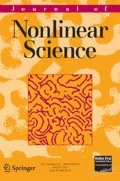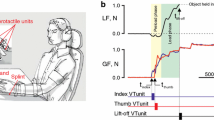Abstract
Slow and accurate finger and limb movements are essential to daily activities, but the underlying mechanics is relatively unexplored. Here, we develop a mathematical framework to examine slow movements of tendon-driven limbs that are produced by modulating the tendons’ stiffness parameters. Slow limb movements are driftless in the sense that movement stops when actuations stop. We demonstrate, in the context of a planar tendon-driven system representing a finger, that the control of stiffness suffices to produce stable and accurate limb postures and quasi-static (slow) transitions among them. We prove, however, that stable postures are achievable only when tendons are pretensioned, i.e., they cannot become slack. Our results further indicate that a non-smoothness in slow movements arises because the precision with which individual stiffnesses need to be altered changes substantially throughout the limb’s motion.









Similar content being viewed by others
References
An, K., Ueba, Y., Chao, E., Cooney, W., Linscheid, R.: Tendon excursion and moment arm of index finger muscles. J. Biomech. 16(6), 419–425 (1983)
Asatryan, D.G., Feldman, A.G.: Functional tuning of the nervous system with control of movement or maintenance of a steady posture: I. mechanographic analysis of the work of the joint or execution of a postural task. Biophysics 10(5), 925–934 (1965)
Bizzini, M., Mannion, A.F.: Reliability of a new, hand-held device for assessing skeletal muscle stiffness. Clin. Biomech. 18(5), 459–461 (2003)
Boscain, U., Chitour, Y.: On the minimum time problem for driftless left-invariant control systems on so (3). Commun. Pure Appl. Anal. 1, 285–312 (2002)
Burdet, E., Osu, R., Franklin, D., Yoshioka, T., Milner, T., Kawato, M.: A method for measuring endpoint stiffness during multi-joint arm movements. J. Biomech. 33(12), 1705–1709 (2000)
Burdet, E., Osu, R., Franklin, D.W., Milner, T.E., Kawato, M.: The central nervous system stabilizes unstable dynamics by learning optimal impedance. Nature 414(6862), 446–449 (2001)
Chen, J., Tian, J., Iwasaki, T., Friesen, W.O.: Mechanisms underlying rhythmic locomotion: dynamics of muscle activation. J. Exp. Biol. 214(11), 1955–1964 (2011)
Chuang, L.-L., Wu, C.-Y., Lin, K.-C.: Reliability, validity, and responsiveness of myotonometric measurement of muscle tone, elasticity, and stiffness in patients with stroke. Arch. Phys. Med. Rehabil. 93(3), 532–540 (2012)
Cooke, J.: The organization of simple, movements. In: Stelmach, G.E., Requin, J. (eds.) Tutorials in Motor Behavior, pp. 199–212. North Holland Publishing Company, Amsterdam (1980)
Darling, W.G., Cole, K.J., Miller, G.F.: Coordination of index finger movements. J. Biomech. 27(4), 479–491 (1994)
De Luca, A., Oriolo, G., Samson, C.: Feedback Control of a Nonholonomic Car-like Robot, Book Section 4, pp. 171–253. Springer, New York (1998)
Evans, C., Baker, S.N.: Task-dependent intermanual coupling of 8-hz discontinuities during slow finger movements. Eur. J. Neurosci. 18(2), 453–456 (2003)
Feldman, A.: Functional tuning of the nervous system with control of movement or maintenance of a steady posture. ii. controllable parameters of the muscle. Biophysics 11(3), 565–578 (1966)
Feldman, A.G., Levin, M.F.: The Equilibrium-Point Hypothesis-Past, Present and Future, vol. 629. Springer, Berlin (2009)
Frecker, M., Snyder, A.J.: Surgical robotics: multifunctional end effectors for robotic surgery. Oper. Techn. Gen. Surg. 7(4), 165–169 (2005)
Giszter, S., Patil, V., Hart, C.: Primitives, premotor drives, and pattern generation: a combined computational and neuroethological perspective. Prog. Brain Res. 165, 323–346 (2007)
Giszter, S.F.: Motor primitives–new data and future questions. Curr. Opin. Neurobiol. 33, 156–165 (2015)
Gross, J., Timmermann, L., Kujala, J., Dirks, M., Schmitz, F., Salmelin, R., Schnitzler, A.: The neural basis of intermittent motor control in humans. Proc. Natl. Acad. Sci. 99(4), 2299–2302 (2002)
Hill, A.: The heat of shortening and the dynamic constants of muscle. Proc. R. Soc. Lond. B Biol. Sci. 126(843), 136–195 (1938)
Hogan, N.: Adaptive control of mechanical impedance by coactivation of antagonist muscles. Autom. Control IEEE Trans. 29(8), 681–690 (1984)
Hogan, N.: Impedance control: an approach to manipulation: Part II–implementation. J. Dyn. Syst. Meas. control 107(1), 8–16 (1985)
Inouye, J.M., Kutch, J.J., Valero-Cuevas, F.J.: A novel synthesis of computational approaches enables optimization of grasp quality of tendon-driven hands. Robot. IEEE Trans. 28(4), 958–966 (2012)
Inouye, J.M., Valero-Cuevas, F.J.: Muscle synergies heavily influence the neural control of arm endpoint stiffness and energy consumption. PLoS Comput. Biol. 12(2), e1004737 (2016)
Ivaldi, F.M., Morasso, P., Zaccaria, R.: Kinematic networks. Biol. Cybern. 60(1), 1–16 (1988)
Jing, F., Alben, S.: Optimization of two-and three-link snakelike locomotion. Phys. Rev. E 87(2), 022711 (2013)
Jung, S.-Y., Kang, S.-K., Lee, M.-J., Moon, I.: Design of robotic hand with tendon-driven three fingers. In: Control, Automation and Systems, 2007. ICCAS’07. International Conference on, IEEE, Year, pp. 83–86
Kanso, E.: Swimming due to transverse shape deformations. J. Fluid Mech. 631, 127–148 (2009)
Kanso, E., Marsden, J.E., Rowley, C.W., Melli-Huber, J.: Locomotion of articulated bodies in a perfect fluid. J. Nonlinear Sci. 15(4), 255–289 (2005)
Lee, Y.-T., Choi, H.-R., Chung, W.-K., Youm, Y.: Stiffness control of a coupled tendon-driven robot hand. Control Syst. IEEE 14(5), 10–19 (1994)
McMahon, T.A.: Muscles, Reflexes, and Locomotion. Princeton University Press, Princeton (1984)
Mussa-Ivaldi, F.A., Hogan, N.: Integrable solutions of kinematic redundancy via impedance control. Int. J. Robot. Res. 10(5), 481–491 (1991)
Mustalampi, S., Häkkinen, A., Kautiainen, H., Weir, A., Ylinen, J.: Responsiveness of muscle tone characteristics to progressive force production. The. J. Strength Cond. Res. 27(1), 159–165 (2013)
Rätsep, T.O., Asser, T.: Changes in viscoelastic properties of skeletal muscles induced by subthalamic stimulation in patients with parkinson’s disease. Clin. Biomech. 26(2), 213–217 (2011)
Shadmehr, R.: The Equilibrium Point Hypothesis for Control of Movement. Department of Biomedical Engineering, Johns Hopkins University, Baltimore (1998)
Shapere, A., Wilczek, F.: Geometry of self-propulsion at low reynolds number. J. Fluid Mech. 198, 557–585 (1989)
Simaan, N., Xu, K., Wei, W., Kapoor, A., Kazanzides, P., Taylor, R., Flint, P.: Design and integration of a telerobotic system for minimally invasive surgery of the throat. Int. J. Robot. Res. 28(9), 1134–1153 (2009)
Srinivasan, M., Ruina, A.: Computer optimization of a minimal biped model discovers walking and running. Nature 439(7072), 72–75 (2006)
Teel, A.R., Murray, R.M., Walsh, G.C.: Non-holonomic control systems: from steering to stabilization with sinusoids. Int. J. Control 62(4), 849–870 (1995)
Valero-Cuevas, F.J.: A mathematical approach to the mechanical capabilities of limbs and fingers. In: Sternad, D. (ed.) Progress in Motor Control. Advances in Experimental Medicine and Biology, vol. 629, pp. 619–633. Springer (2009)
Valero-Cuevas, F.J.: Fundamentals of Neuromechanics, vol. 8 of Biosystems and Biorobotics. Springer, London (2015)
Valero-Cuevas, F.J., Yi, J.-W., Brown, D., McNamara, R.V., Paul, C., Lipson, H.: The tendon network of the fingers performs anatomical computation at a macroscopic scale. Biomed. Eng. IEEE Trans. 54(6), 1161–1166 (2007)
Valero-Cuevas, F.J., Zajac, F.E., Burgar, C.G.: Large index-fingertip forces are produced by subject-independent patterns of muscle excitation. J. Biomech. 31(8), 693–703 (1998)
Vallbo, A., Wessberg, J.: Organization of motor output in slow finger movements in man. J. Phys. 469(1), 673–691 (1993)
Whitney, D.E.: Resolved motion rate control of manipulators and human prostheses. IEEE Trans. Man Machine. MMS-10(2), 47–53 (1969). doi:10.1109/TMMS.1969.299896
Williams, E.R., Soteropoulos, D.S., Baker, S.N.: Coherence between motor cortical activity and peripheral discontinuities during slow finger movements. J. Neurophysiol. 102(2), 1296–1309 (2009)
Williams, T.L.: A new model for force generation by skeletal muscle, incorporating work-dependent deactivation. J. Exp. Biol. 213(4), 643–650 (2010)
Acknowledgments
S. B. and F. V. C. were partially supported by the grants NIH R01AR050520, NIH R01AR052345, NIDRR H133E080024 and NSF EFRI-COPN 0836042, and S. B. and E. K. by the Grants NSF CMMI-0644925 and NSF CCF-0811480. The content is solely the responsibility of the authors and does not necessarily represent the official views of the National Institutes of Health.
Conflict of interest
The authors declare that they have no conflict of interest.
Author information
Authors and Affiliations
Corresponding author
Additional information
Communicated by Paul K. Newton.
Valero-Cuevas and Kanso have equal leadership of this paper.
Rights and permissions
About this article
Cite this article
Babikian, S., Valero-Cuevas, F.J. & Kanso, E. Slow Movements of Bio-Inspired Limbs. J Nonlinear Sci 26, 1293–1309 (2016). https://doi.org/10.1007/s00332-016-9305-x
Received:
Accepted:
Published:
Issue Date:
DOI: https://doi.org/10.1007/s00332-016-9305-x




